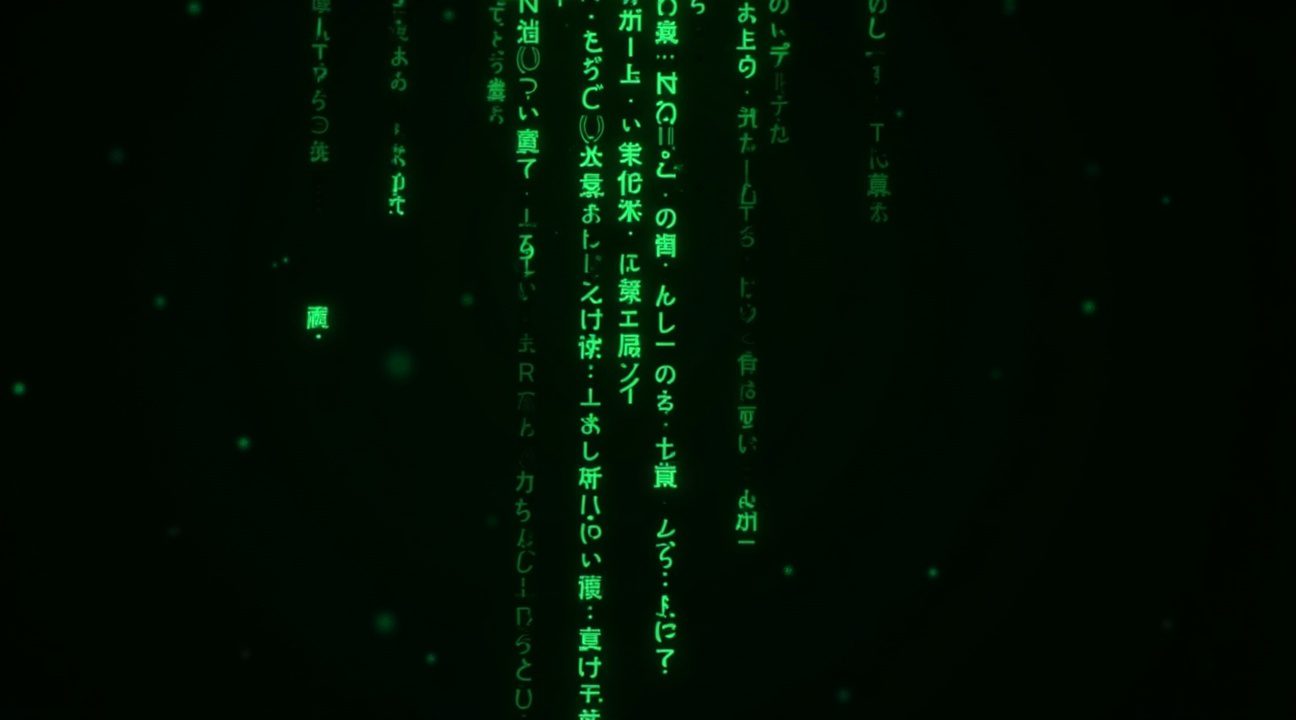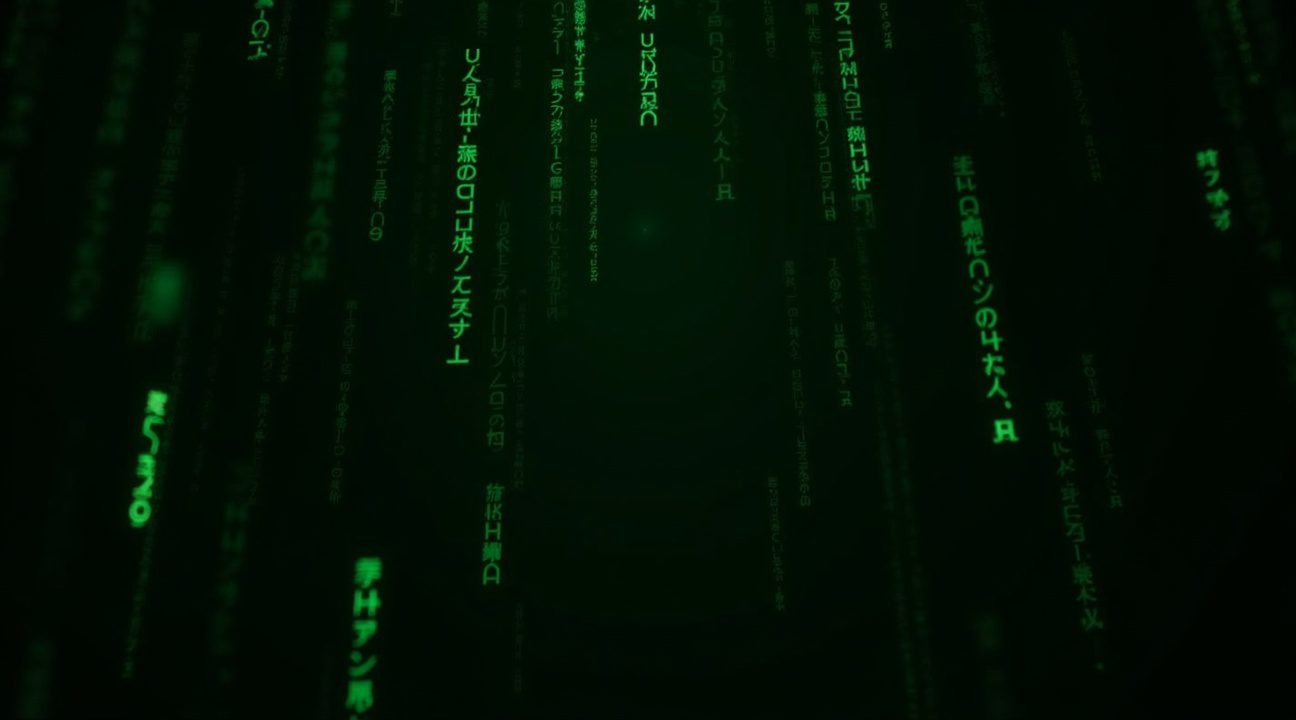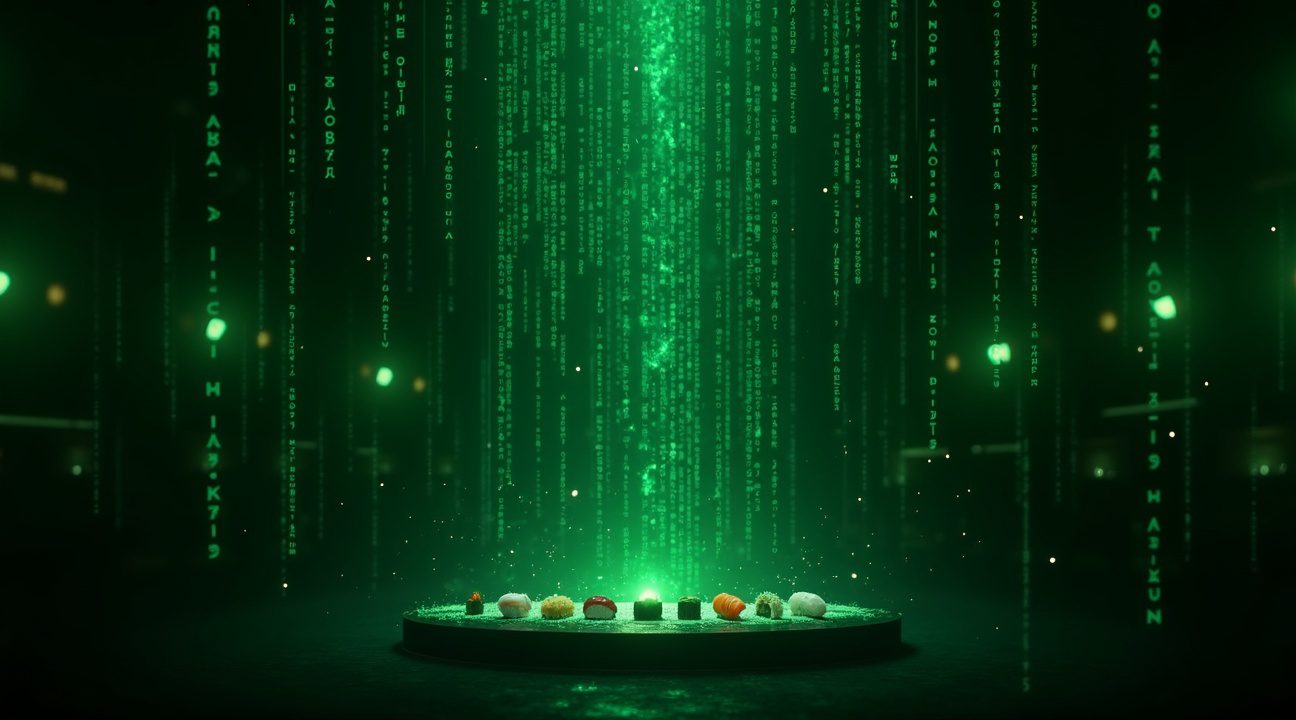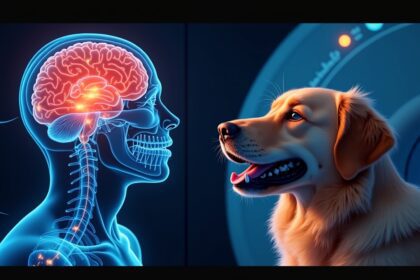The iconic green cascading code that captivated audiences in The Matrix carries a surprisingly delightful secret – those mysterious digital characters are actually Japanese sushi recipes from cookbooks.
Key Takeaways
- The Matrix’s falling green code originated from Japanese cookbooks containing sushi recipes, specifically using katakana characters that production designer Simon Whiteley scanned and digitally modified.
- The characters underwent extensive artistic transformation including flipping, rotating, and distortion, making them unreadable as actual recipes despite their authentic Japanese origins.
- Whiteley chose katakana over other Japanese writing systems because its angular, geometric appearance perfectly complemented the film’s cyberpunk aesthetic while maintaining cultural authenticity.
- The digital rain combines multiple elements including modified Japanese characters, Arabic numerals, hand-drawn symbols, and custom glyphs that don’t exist in any real language.
- This creative choice has become a lasting cultural symbol appearing across video games, websites, and popular media, demonstrating how practical filmmaking solutions can achieve unexpected cultural immortality.
For more insights into the behind-the-scenes elements of The Matrix, you can explore interviews and articles where Simon Whiteley reveals the origins of the code effect.
The Matrix’s Green Code Actually Contains Japanese Sushi Recipes
The green cascading characters that defined The Matrix’s visual identity carry a surprisingly delicious secret. What audiences worldwide interpreted as mysterious computer code was actually something far more ordinary yet equally fascinating. Simon Whiteley, the production designer for The Matrix, revealed that the iconic “digital rain” originated from Japanese cookbooks belonging to his wife, specifically featuring sushi recipes.
The creation process involved scanning Japanese characters, mainly katakana, directly from these cookbooks and alphabet sheets. Whiteley transformed everyday cooking instructions into the film’s most recognizable visual element. The characters that appear to represent complex programming languages or alien communications actually describe how to prepare various types of sushi, from basic maki rolls to more elaborate preparations.
From Kitchen to Cyberpunk Cinema
This revelation highlights an extraordinary example of creative resourcefulness in film production. Instead of developing entirely fictional symbols or using complex computer-generated text, the production team found inspiration in the most unexpected place – a home kitchen. The Japanese katakana characters provided the perfect aesthetic for the film’s cyberpunk atmosphere while maintaining authentic cultural roots.
The decision to use sushi recipes wasn’t entirely random. Japanese culture has long been associated with technological advancement and futuristic aesthetics in science fiction cinema. The katakana writing system, with its angular and geometric appearance, naturally complemented the film’s digital themes. These characters created the perfect illusion of advanced computer programming while actually describing ingredients, preparation methods, and traditional sushi-making techniques.
Production teams often face tight deadlines and budget constraints that require innovative solutions. Whiteley’s approach demonstrates how effective visual storytelling can emerge from readily available materials. Rather than spending extensive time and resources creating fictional languages or complex digital displays, the team achieved their goals using existing Japanese text that happened to possess the exact visual qualities they needed.
The cultural significance extends beyond mere convenience. Japanese cuisine represents precision, artistry, and tradition – qualities that mirror the film’s themes about reality, perception, and craftsmanship. Sushi preparation requires careful attention to detail, much like the meticulous world-building evident throughout The Matrix. This unintentional connection between culinary arts and digital storytelling adds another layer of meaning to the film’s visual language.
The discovery emphasizes what Whiteley described as the “blending of the mundane with the profound.” Ordinary sushi recipes became the foundation for one of cinema’s most memorable visual effects. Audiences watching Neo learn to read the Matrix code were actually observing instructions for preparing salmon rolls, tuna sashimi, and rice seasoning techniques. This transformation of everyday content into something that appears otherworldly speaks to the power of context in visual communication.
Film historians and Matrix enthusiasts continue to find new appreciation for this creative choice. The revelation adds depth to viewing experiences, as fans can now recognize that the seemingly incomprehensible code carries actual meaning – just not the meaning they initially assumed. Some dedicated viewers have even attempted to decode specific recipes from freeze-frame analysis of the falling characters.
The impact extends beyond The Matrix trilogy itself. This approach has influenced how other filmmakers think about creating believable digital environments. Rather than always starting from scratch, production designers now often look for existing materials that can be repurposed creatively. The success of using sushi recipes as digital code demonstrates that authenticity often comes from unexpected sources.
Modern audiences might view this revelation as either charming or disappointing, depending on their perspective. Some appreciate the ingenuity and cultural connection, while others prefer the mystery of unknown symbols. Regardless of individual reactions, the sushi recipe revelation has become an integral part of Matrix trivia, adding another dimension to the film’s already rich mythology and continuing cultural influence.
What Characters Actually Make Up the Digital Rain
I’ve discovered that the Matrix’s iconic green code consists of a fascinating blend of Japanese katakana characters, Arabic numerals, and hand-drawn symbols that create the film’s distinctive digital aesthetic. Katakana, the syllabic script typically used for foreign words in Japanese, forms the backbone of this visual effect due to its clean, angular strokes that translate beautifully on screen.
The production designer Simon Whiteley made a deliberate choice to use katakana instead of the traditional hiragana and kanji characters typically found in authentic sushi recipes. This decision wasn’t arbitrary – katakana’s geometric simplicity provided the perfect visual impact for the big screen presentation that the Wachowski sisters envisioned.
The Hand-Drawn Element
Whiteley enhanced the digital rain by hand-drawing many of the characters and symbols, creating an intentionally imperfect, organic quality that contrasts beautifully with the sterile digital world. This artistic approach prevented the code from looking too mechanical or computer-generated, which would have undermined the film’s themes about artificial reality.
The hand-drawn modifications included distorted characters, flipped symbols, and artistic embellishments that don’t exist in standard Japanese writing systems. These additions gave the falling code its unique personality and helped establish the Matrix’s distinct visual language that has influenced countless films since its release.
Beyond Simple Sushi Recipes
While popular culture often repeats the story that the Matrix code consists entirely of sushi recipes, the reality proves more complex and interesting. The character set draws from multiple sources, including Japanese cookbook content, but it’s not limited to readable recipes. Whiteley incorporated elements from:
- Japanese cookbook pages for authentic character references
- Alphabet practice sheets for additional symbol variety
- Custom artistic modifications and original symbols
- Numerical sequences using Arabic digits
- Geometric shapes and abstract elements
The cookbook content provided a foundation, but Whiteley transformed these source materials into something entirely new. He flipped characters horizontally, rotated them at unusual angles, and created hybrid symbols that blur the line between authentic Japanese writing and pure artistic expression. This approach ensures that while Japanese speakers might recognize individual katakana characters, they won’t find coherent recipes or meaningful text streaming down the screen.
The choice to use Japanese characters wasn’t just aesthetic – it served the film’s deeper themes about language, communication, and understanding. For Western audiences, the unfamiliar script reinforces the alien nature of the Matrix’s code, while the occasional recognizable numeral or symbol creates moments of partial comprehension that mirror Neo’s gradual awakening to the digital world’s true nature.
Modern analysis of the code reveals that Whiteley’s creative process involved photographing pages from his wife’s Japanese cookbooks, then digitally manipulating and hand-modifying the characters to create the final effect. This blend of traditional source material with cutting-edge digital artistry perfectly embodies the Matrix’s central theme of reality versus simulation.
The enduring appeal of the Matrix code lies not in its literal meaning but in its visual poetry. Each cascading column tells a story through movement and rhythm rather than readable text, creating a universal language that transcends cultural boundaries while maintaining its mysterious, otherworldly quality. The characters dance down the screen like digital rain, transforming simple cookbook references into one of cinema’s most recognizable visual metaphors for the intersection of technology and consciousness.
This careful balance between authentic source material and artistic license demonstrates how effective production design can transform mundane references into iconic imagery that resonates with audiences decades after its creation.
How the Iconic Visual Effect Was Created
The visual effects team behind The Matrix took an unconventional approach when crafting the film’s legendary digital rain. I’ve discovered that the production crew actually scanned authentic Japanese sushi recipes and transformed them into the cascading green code that audiences worldwide recognize today. This creative decision wasn’t arbitrary – it reflected the filmmakers’ deep appreciation for Japanese culture and their desire to create something genuinely authentic beneath the surface.
Technical Transformation Process
The original sushi recipe text underwent extensive digital manipulation to achieve its final cinematic form. Artists vertically flipped the characters and applied heavy stylization to simulate flowing digital information, drawing inspiration from traditional Japanese text layout while repurposing it for a distinctly cyber aesthetic. This process created an interesting cultural bridge between ancient culinary traditions and futuristic digital concepts.
Digital artists enhanced the scanned recipes by adding extra lines, dots, and intentional artifacts throughout the composition. These imperfections were crucial for achieving a stylized, deliberately flawed digital effect that felt more organic than perfect computer-generated text. The team wanted viewers to sense something familiar yet unidentifiable in the falling characters, creating subconscious recognition without explicit understanding.
Visual Design Choices
The distinctive green color scheme wasn’t chosen randomly – it deliberately emulates the phosphor screens found on vintage IBM CRT monitors. This color choice added layers of nostalgia while maintaining an otherworldly quality that perfectly suited the film’s themes. The green hue also provided optimal contrast against the dark backgrounds, ensuring the falling text remained clearly visible during action sequences.
Production teams combined the manipulated sushi recipe characters with additional numbers and symbols, creating a hybrid visual language that felt both foreign and strangely familiar. The mixture was then digitally animated to flow vertically down screens throughout the film’s opening sequence and various computer interface scenes. This technique proved so effective that it became one of cinema’s most recognizable visual motifs, spawning countless imitations and parodies across different media.
The irony remains delicious – while audiences perceived complex digital code representing advanced artificial intelligence, they were actually viewing instructions for preparing traditional Japanese delicacies like tekken rolls and sashimi platters. This hidden layer adds unexpected depth to repeat viewings, knowing that Neo’s digital world literally contains the recipes for creating authentic Japanese cuisine.

Why You Can’t Actually Read Sushi Recipes in the Movie
I’ve examined the famous green code extensively, and while the inspiration comes from cookbook sources, the Matrix’s digital rain doesn’t function as readable culinary text. The characters you see cascading down the screen underwent significant artistic transformation that renders them unusable as actual cooking instructions.
Stylized Beyond Recognition
The original cookbook material served merely as a foundation for creating authentic-looking Japanese characters. However, the production team heavily modified these symbols to achieve the desired visual effect. Japanese speakers who’ve attempted to decode the falling text report that individual characters appear fragmented and distorted. The artistic process involved stretching, rotating, and manipulating the original glyphs until they became unrecognizable as functional text.
Mixed Symbol Systems Create Confusion
Another significant barrier to reading the code lies in its hybrid composition. The designers didn’t limit themselves to pure Japanese writing systems but instead incorporated various non-Japanese symbols throughout the digital streams. This creative decision, while visually striking, makes interpretation impossible even for native speakers. The mixture includes:
- Modified hiragana and katakana characters
- Distorted kanji symbols
- Random Latin letters and numbers
- Custom-designed glyphs that don’t exist in any language
- Reversed or mirrored versions of legitimate characters
I find it fascinating that gaming culture has embraced similar aesthetic choices in recent years. The fragmented nature of these symbols means that even if someone possessed the original cookbook pages, they couldn’t reconstruct coherent recipes from what appears on screen. Each character exists as an isolated visual element rather than part of meaningful text.
The production team’s priority focused on creating an otherworldly digital aesthetic rather than maintaining linguistic accuracy. This approach explains why attempts to decode the Matrix through traditional translation methods have consistently failed. The code represents a brilliant example of how visual storytelling can prioritize artistic impact over literal meaning.
The stylization process transformed functional cookbook text into purely decorative elements that serve the film’s narrative purpose without retaining their original informational value. This artistic choice created one of cinema’s most recognizable visual effects while simultaneously making the underlying content completely inaccessible to viewers.

The Cultural Legacy of Matrix Code
I find it fascinating how the iconic digital rain from The Matrix has transcended its cinematic origins to become a universal symbol of the digital age. Video games frequently borrow this visual language, while countless websites and applications use falling green characters to evoke themes of hacking, artificial intelligence, and virtual reality.
Simon Whiteley’s revelation that those mysterious symbols cascading down the screen were actually sushi recipes adds an unexpected layer to this cultural phenomenon. The production designer’s playful admission transforms what audiences perceived as complex computer code into something far more mundane yet equally authentic—Japanese culinary instructions written in katakana characters.
This connection between Japanese cookbooks and Hollywood sci-fi aesthetics creates a unique cultural fusion that speaks to the global nature of modern filmmaking. The Matrix drew heavily from Japanese anime and philosophy, making the use of actual Japanese text particularly fitting. Whiteley’s choice to use real sushi recipes rather than random characters demonstrates the attention to detail that elevated the film’s visual effects beyond typical movie magic.
From Screen to Symbol
The digital rain has spawned countless memes, parodies, and homages across popular culture. I’ve observed how this visual motif appears in everything from animated films to corporate presentations attempting to appear tech-savvy. The falling green characters have become shorthand for several concepts:
- Cyberpunk and dystopian futures
- Computer programming and hacking culture
- Virtual reality and simulated environments
- The intersection of human consciousness and digital technology
- Modern anxiety about our relationship with technology
The irony that these symbols represent something as comforting and traditional as sushi preparation instructions adds depth to the Matrix’s commentary on reality versus perception. Documentary filmmakers and cultural critics have noted how this detail exemplifies the film’s central theme—that what we perceive as one thing may be something entirely different underneath.
Whiteley’s choice reflects the cyberpunk genre’s fascination with Japanese culture, a trend that began decades before The Matrix with works like Blade Runner and Neuromancer. The use of authentic katakana characters from Japanese cookbooks grounds the fantastical elements in real cultural artifacts, creating a bridge between the exotic and the familiar.
The lasting impact of this visual design extends far beyond entertainment. I’ve noticed how the falling code aesthetic has influenced user interface design, particularly in applications dealing with data visualization or cybersecurity. Technology companies often reference this imagery when marketing products related to data analysis or digital transformation.
Matrix trivia enthusiasts continue to discover new layers of meaning in Whiteley’s design choices. The fact that audiences spent years speculating about the meaning of these characters—some even attempting to decode them as mathematical formulas or programming languages—only to learn they contained instructions for preparing tuna rolls and salmon nigiri, perfectly embodies the film’s exploration of illusion and reality.
Celebrity culture has also embraced the Matrix aesthetic, with performers and influencers using digital rain effects in music videos and social media content. This widespread adoption demonstrates how a single visual effect, born from practical necessity and creative inspiration, can achieve cultural immortality.
The green falling code represents more than just clever visual effects—it’s become a modern hieroglyph representing humanity’s complex relationship with technology. Visual storytelling rarely achieves such universal recognition, making Whiteley’s sushi recipe revelation all the more delightful. His admission adds a layer of warmth and humanity to what many perceived as cold, algorithmic imagery, reminding us that even the most sophisticated illusions often have surprisingly simple origins.

Sources:
Snopes, “The Matrix’ Rain of Green, Digital Code Was Inspired by Sushi Recipes”
SYFY, “Where Did The Matrix Green Code Language Come From?”
Goatland (YouTube), “The Matrix Code: How Sushi Recipes Inspired the Iconic Digital Rain”
Science Fiction Classics, “How Sushi Shaped The Matrix Code”
The Independent, “The Iconic Green Code in The Matrix Is Just Sushi Recipes”
Wikipedia, “Digital Rain”

